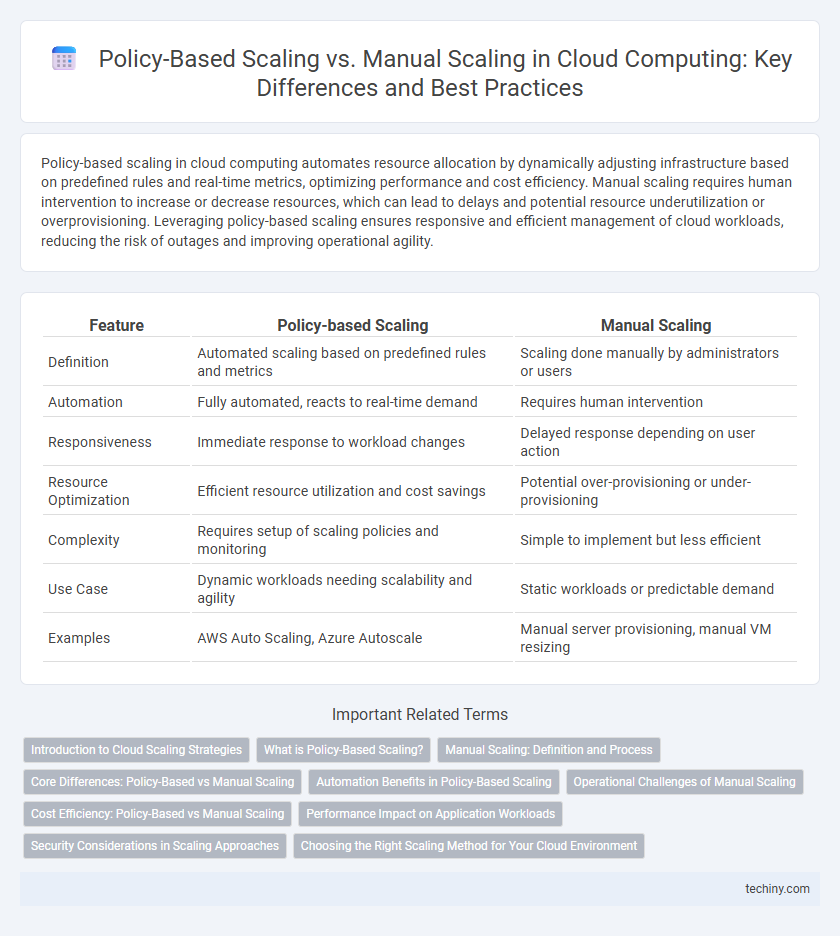Policy-based scaling in cloud computing automates resource allocation by dynamically adjusting infrastructure based on predefined rules and real-time metrics, optimizing performance and cost efficiency. Manual scaling requires human intervention to increase or decrease resources, which can lead to delays and potential resource underutilization or overprovisioning. Leveraging policy-based scaling ensures responsive and efficient management of cloud workloads, reducing the risk of outages and improving operational agility.
Table of Comparison
| Feature | Policy-based Scaling | Manual Scaling |
|---|---|---|
| Definition | Automated scaling based on predefined rules and metrics | Scaling done manually by administrators or users |
| Automation | Fully automated, reacts to real-time demand | Requires human intervention |
| Responsiveness | Immediate response to workload changes | Delayed response depending on user action |
| Resource Optimization | Efficient resource utilization and cost savings | Potential over-provisioning or under-provisioning |
| Complexity | Requires setup of scaling policies and monitoring | Simple to implement but less efficient |
| Use Case | Dynamic workloads needing scalability and agility | Static workloads or predictable demand |
| Examples | AWS Auto Scaling, Azure Autoscale | Manual server provisioning, manual VM resizing |
Introduction to Cloud Scaling Strategies
Policy-based scaling automates resource allocation by using predefined rules and metrics, ensuring dynamic adaptation to workload changes in real-time. Manual scaling requires administrators to adjust resources based on monitoring data, which can lead to delays and inefficient resource use during workload spikes. Implementing policy-based scaling enhances cloud infrastructure efficiency, reduces operational overhead, and improves application performance by responding proactively to demand fluctuations.
What is Policy-Based Scaling?
Policy-based scaling in cloud computing automates resource management by using predefined rules and metrics to adjust the capacity of applications or services dynamically. This method optimizes performance and cost-efficiency by automatically increasing or decreasing resources based on demand patterns such as CPU usage, memory consumption, or network traffic. Unlike manual scaling, which requires human intervention, policy-based scaling ensures consistent responsiveness and operational efficiency under varying workloads.
Manual Scaling: Definition and Process
Manual scaling in cloud computing involves adjusting server resources or instances by direct user intervention rather than automated rules. This process requires administrators to monitor system performance and manually increase or decrease capacity based on demand. Manual scaling is advantageous when precise control is needed, but it can lead to delays in resource allocation during rapid traffic changes.
Core Differences: Policy-Based vs Manual Scaling
Policy-based scaling automates resource allocation by using predefined rules and metrics such as CPU utilization or network traffic, ensuring dynamic adjustment to workload changes without human intervention. Manual scaling requires administrators to monitor system performance and adjust resources manually, often leading to slower response times and potential overprovisioning or underutilization. The core difference lies in automation and responsiveness: policy-based scaling offers proactive and efficient resource management, while manual scaling depends on reactive human decisions.
Automation Benefits in Policy-Based Scaling
Policy-based scaling in cloud computing leverages automated rules to dynamically adjust resources based on real-time workload metrics, significantly reducing the risk of human error and improving response time during traffic spikes. This automation ensures optimized resource utilization and cost efficiency by scaling resources precisely when needed without manual intervention. Cloud platforms with policy-based scaling typically enhance operational agility and reliability through continuous monitoring and proactive adjustments.
Operational Challenges of Manual Scaling
Manual scaling in cloud computing often leads to operational challenges such as increased human error, delayed response times to demand fluctuations, and inefficient resource utilization. Without automated policy-based triggers, IT teams must continuously monitor workloads and adjust resources, resulting in higher labor costs and potential service disruptions. This approach lacks the dynamic adaptability provided by policy-based scaling, which can automatically optimize infrastructure according to predefined rules.
Cost Efficiency: Policy-Based vs Manual Scaling
Policy-based scaling automates resource allocation by dynamically adjusting capacity based on predefined performance metrics, leading to significant cost savings through optimized usage and reduced overprovisioning. Manual scaling often results in higher operational costs due to delayed adjustments and potential resource wastage during unexpected demand fluctuations. Cloud service providers like AWS and Azure promote policy-based scaling as a cost-efficient strategy that aligns infrastructure expenses closely with actual workload requirements.
Performance Impact on Application Workloads
Policy-based scaling dynamically adjusts resources in response to real-time workload demands, ensuring optimal performance and minimizing latency during traffic spikes. Manual scaling relies on predefined resource allocation or operator intervention, which often leads to over-provisioning or resource shortages that degrade application performance. Automated policy-driven adjustments enhance application responsiveness and cost-efficiency by aligning capacity precisely with workload fluctuations.
Security Considerations in Scaling Approaches
Policy-based scaling enhances security by automating resource allocation based on predefined rules, ensuring consistent application of security policies during scaling events. Manual scaling increases the risk of human error, potentially leading to misconfigurations that expose vulnerabilities or cause compliance lapses. Implementing automated scaling policies helps maintain robust access controls and data protection standards, reducing the attack surface during dynamic infrastructure changes.
Choosing the Right Scaling Method for Your Cloud Environment
Policy-based scaling automates resource allocation by monitoring predefined metrics such as CPU usage or network traffic, ensuring efficient handling of variable workloads without constant manual intervention. Manual scaling allows precise control over resource adjustments, suited for predictable or stable environments where sudden changes are rare and administrative oversight is preferred. Selecting the right scaling method depends on workload patterns, required responsiveness, and the level of automation desired to balance cost, performance, and operational complexity in your cloud infrastructure.
Policy-based Scaling vs Manual Scaling Infographic

 techiny.com
techiny.com